What Makes Erling Haaland So Good?
Erling Haaland is a unique talent in many ways.
As a youth international, he scored nine goals in a game, upon arriving in Dortmund, he scored on his debuts in the Bundesliga, DFB-Pokal, and Champions League (becoming the first player in history to do this), he scored eight goals in his first four Bundesliga games, and 25 in his first 25.
He is also the youngest player to score 20 Champions League goals.
Haaland will continue to break records as his career develops — it is almost shocking that he is still only 21 years of age right now.
His ability as a finisher is undeniable.
Haaland is regularly seen striking the ball ferociously past a helpless keeper with his cannon of a left foot, but to his credit, Haaland is very well-rounded.
He is confident taking on shots with his right and given his 6’4” | 194 cm height, he is also excellent in the air.
This height, along with his finishing prowess and pace, makes him arguably one of, if not the most well-rounded striker operating in world football today.
As a finisher, Haaland operates almost strictly in the box, as we can determine from his shot map for club and country from this season.
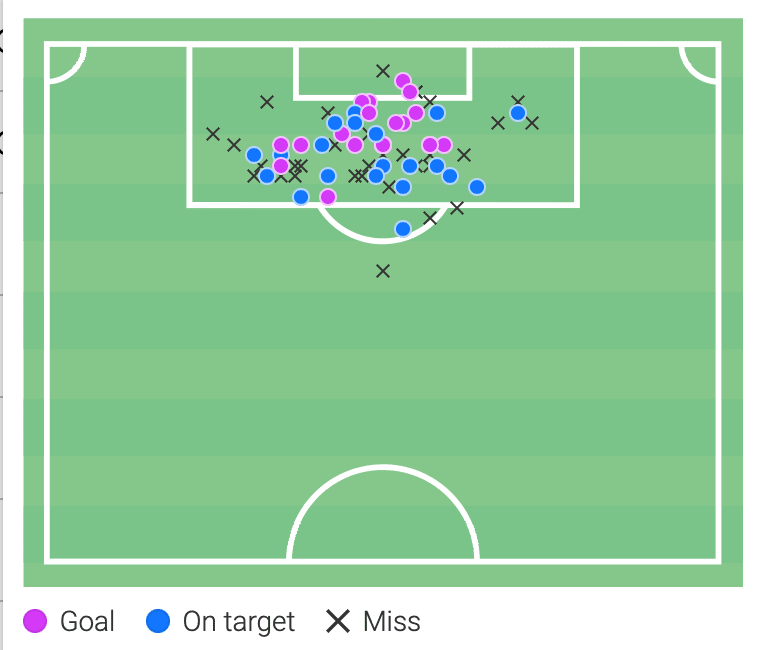
Firstly, there is a lot hitting the target, and secondly — and unsurprisingly — a lot going in.
Admittedly, Haaland is less dangerous from either side of the box but isn’t taking a large volume of shots from these angles.
He does, however, drop off slightly in goal conversion when shooting from anywhere south of the penalty spot.
However, this isn’t an issue, it merely shows Haaland’s preference for positions to shoot from.
The vast bulk of shots are coming from within 12 yards, and for anyone familiar with Haaland’s game, you will likely be able to instantly visualise the trademark first-time Haaland finish coming from a first-time shot following a cross or through pass into this area.
While Haaland’s finishing is truly of the highest quality, it is his movement that provides these opportunities.
In fact, this writer would argue Haaland’s movement is unparalleled in world football right now.
His instinct for areas to move into, but timing and, of course, speed when looking to find space, is outstanding.
To my knowledge, Haaland is the first player that has ever had a tactical analysis written solely on his movement on Total Football Analysis.
This article will provide an analysis on some of Haaland tactics as a forward.
Playing off the blindside
The first tenant of his movement that we often see is Haaland continuously using the blind side of the opposition centre-back to find space.
He will often linger on the outside shoulder of the centre-back marking him but will vary this and drift in front of the centre-back too, constantly forcing them to have to check their position against Haaland’s whilst also watching the ball.
Given Haaland’s acceleration and timing of his runs, this makes him incredibly difficult to mark in the first place.
We can see him initially darting in front of the centre-back in the following image before angling once more towards the blindside.
With this short, sharp movement, he drags the centre-back forward slightly and creates a gap between the two centre-backs that he can fill.
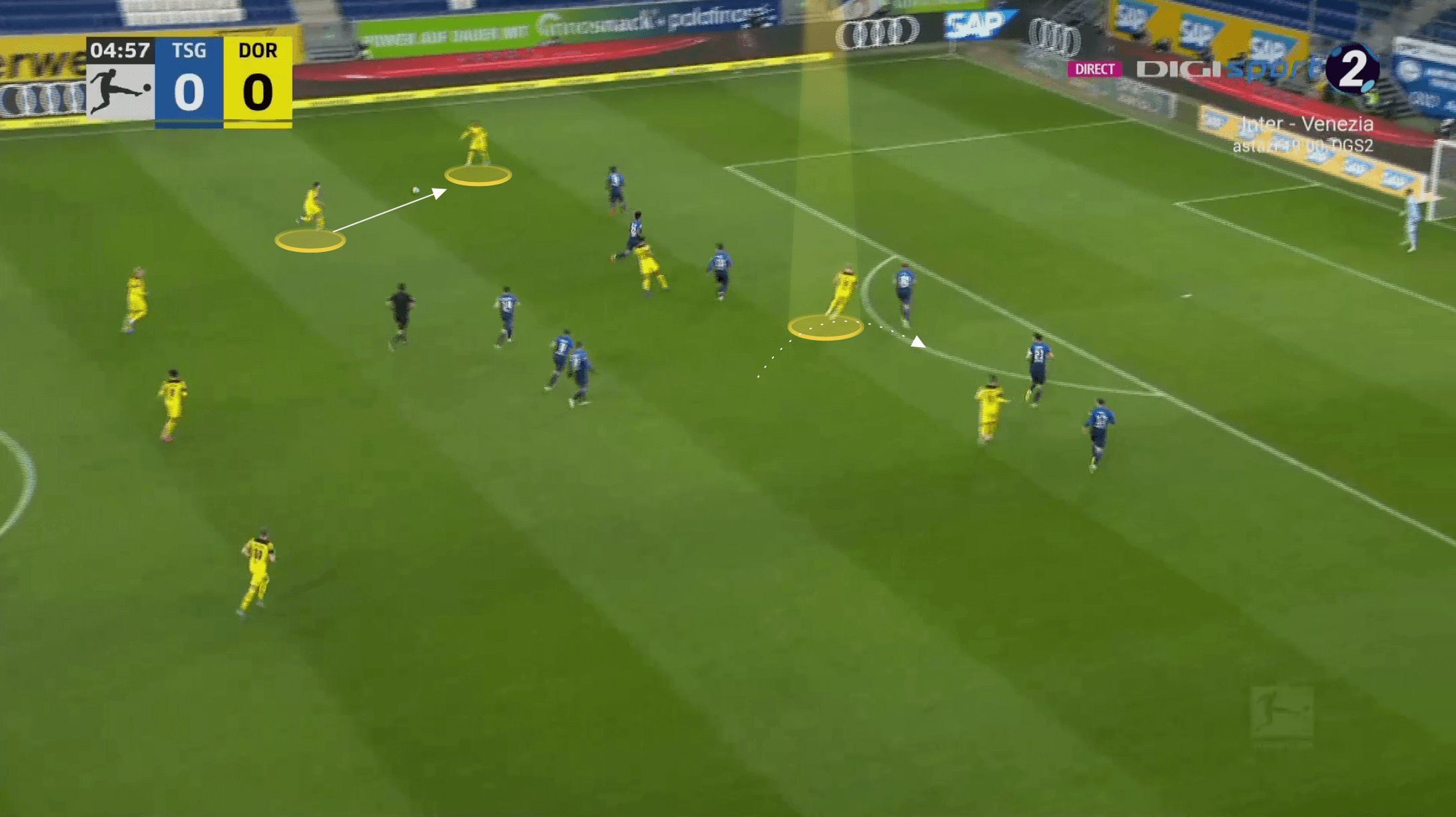
As the ball progresses in this attack, only seconds after the previous frame, we can see how Haaland is now positioned behind both centre-backs, with the defender’s attention drawn towards the action; given their proximity to the Dortmund forward they don’t feel uneasy about his positioning.
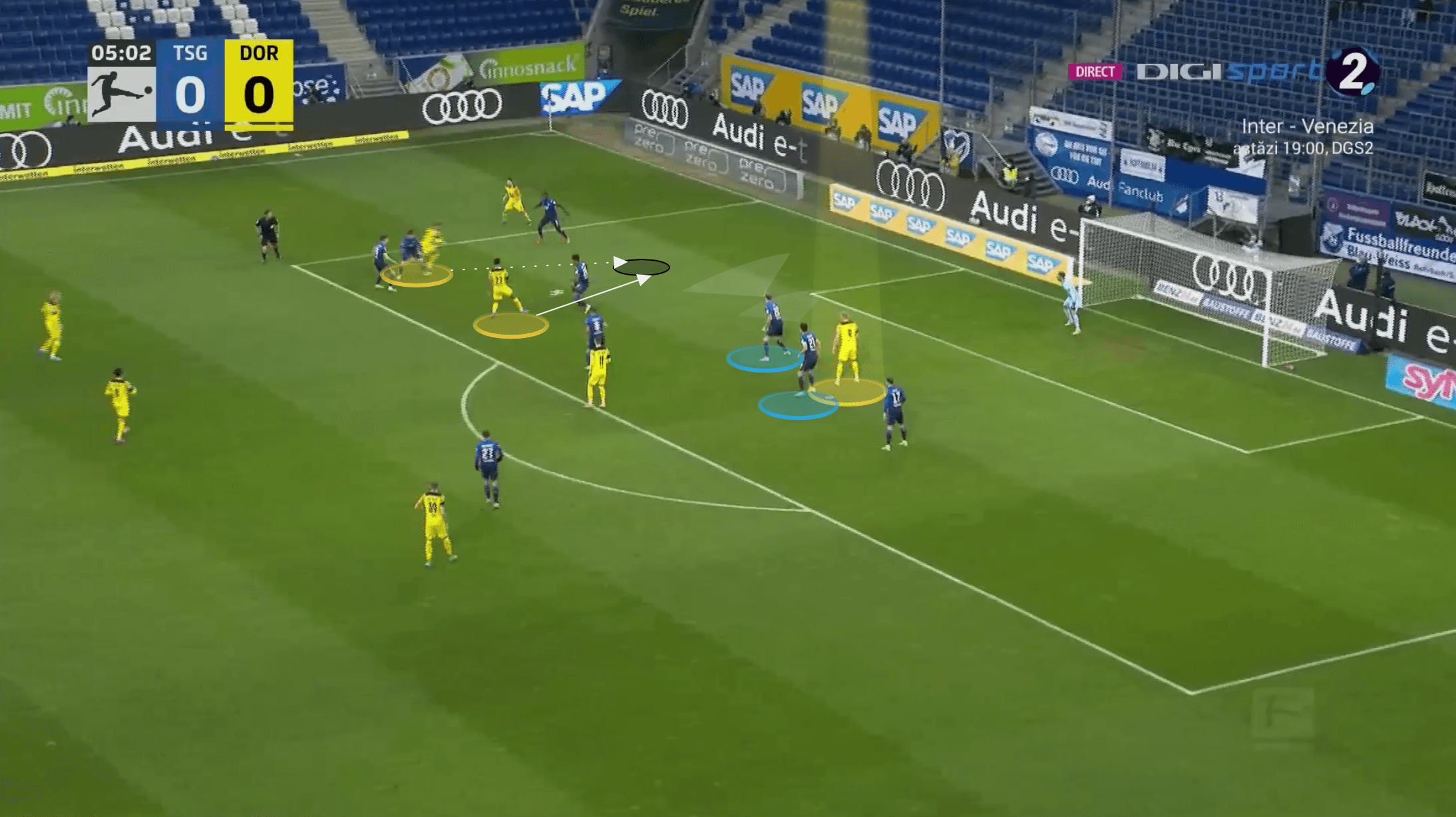
Only a matter of moments later, however, following a slight move towards the front post, before checking back on himself, Haaland is able to easily steal space at the back post, from where he can prod home just yards away from goal.
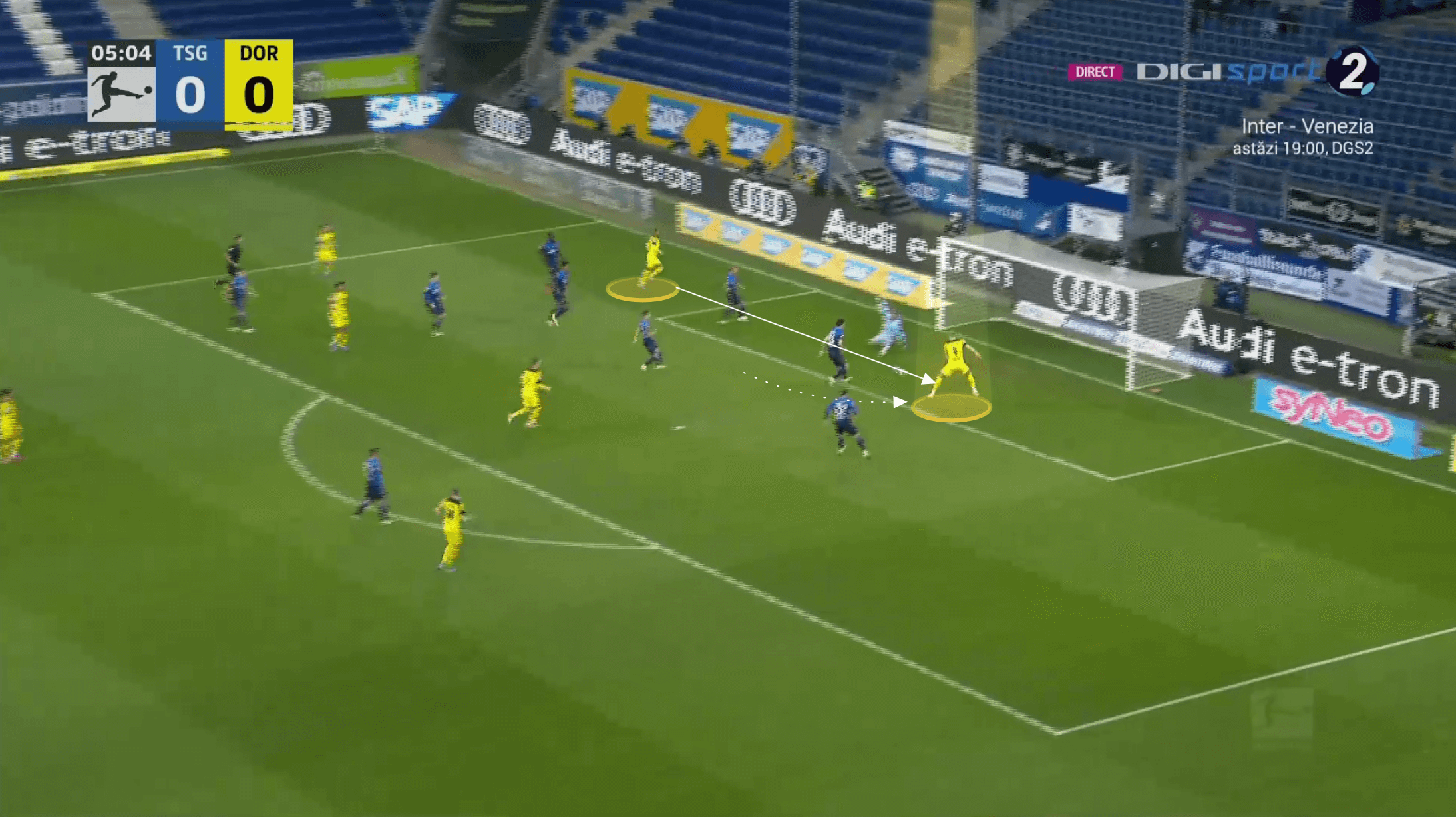
We can see Haaland lingering on the blindside of the opposition left-back in the following image, moving entirely away from the centre-backs and isolating himself against just one defender.
This is a terrible match-up for almost any defender, but particularly an undersized full-back.
With the timing of his runs, you will note that Haaland is never in any rush to do anything.
He is perfectly happy to wait until the last moment.
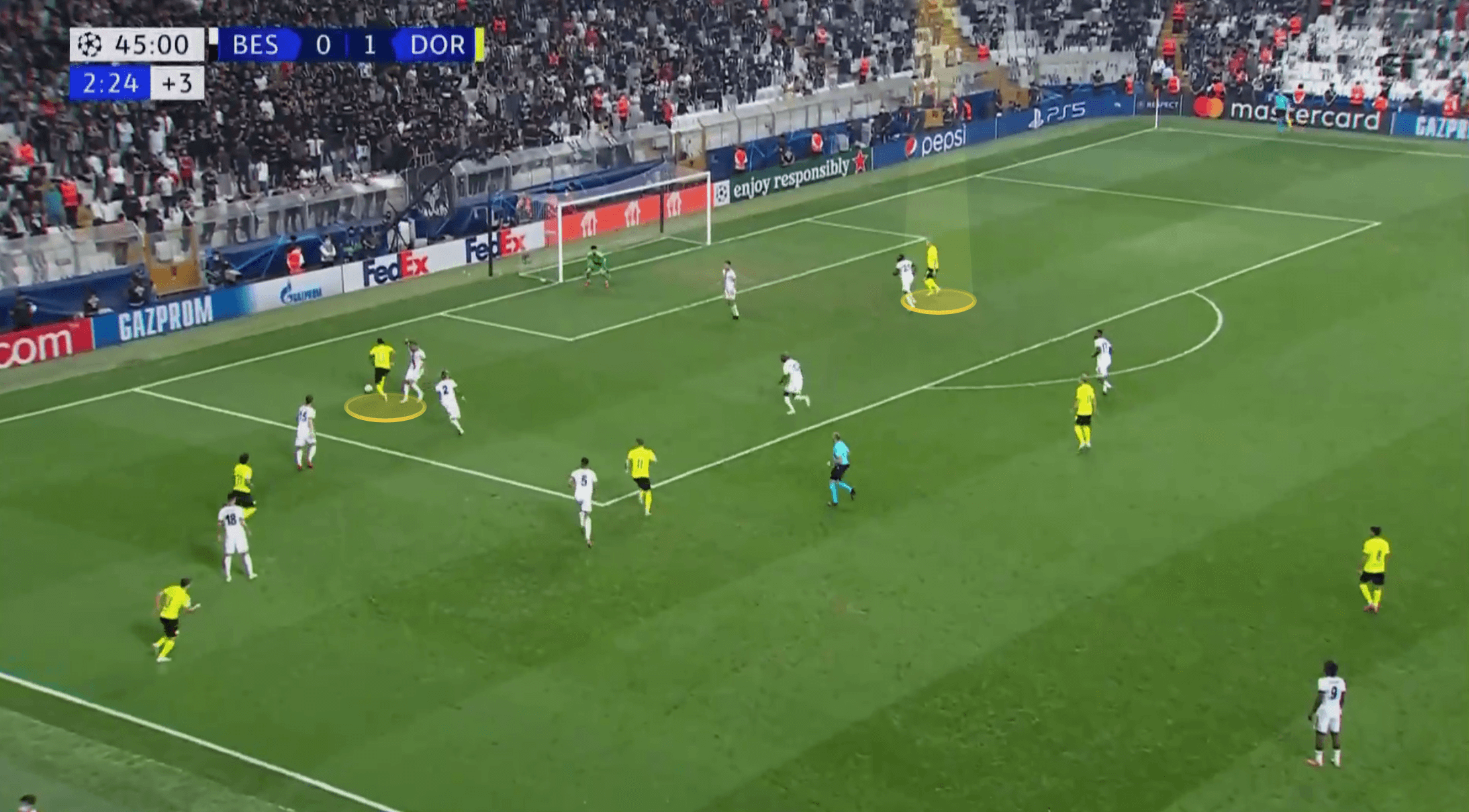
In this case, he sees that the full-back is dropping back in a straight line towards their front post.
From his position on the blindside, he quickly cuts inside to get in front of them.
In doing so, he is able to find space on the six-yard line to receive the pull-back cross.
From this distance, he doesn’t miss.
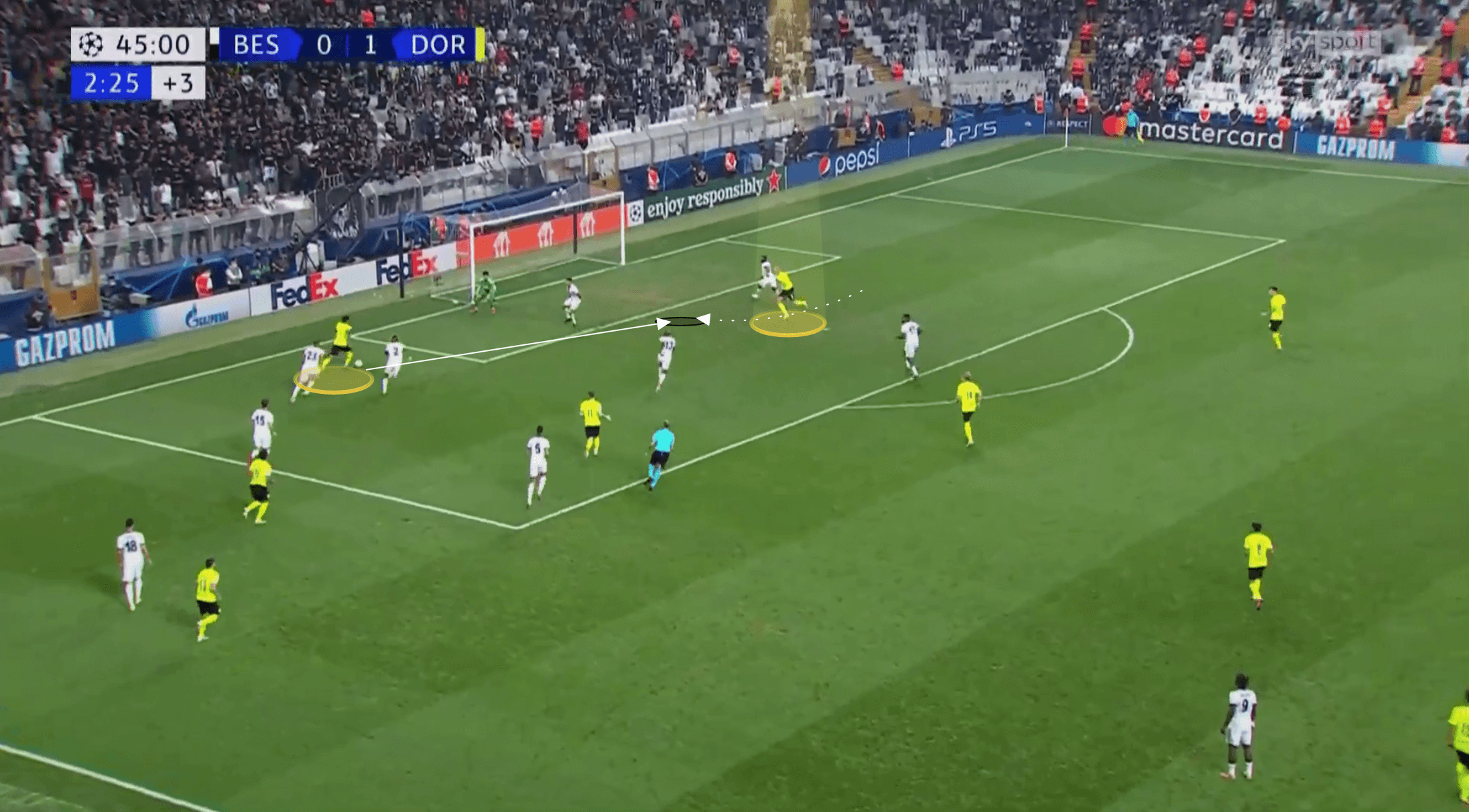
The double movement
Another type of movement that is so prevalent throughout his game is his tendency to manipulate the positioning of the opponent marking him, and in doing so, creating space for himself to receive the ball through a double movement.
Generally speaking, this comes with him leading either to the front or back post initially before darting back the other way, although he can do this with his back to goal as well if the ball is in a central position.
He did so on international duty for Norway drawing a Gibraltar defender with him as he moved towards the ball.
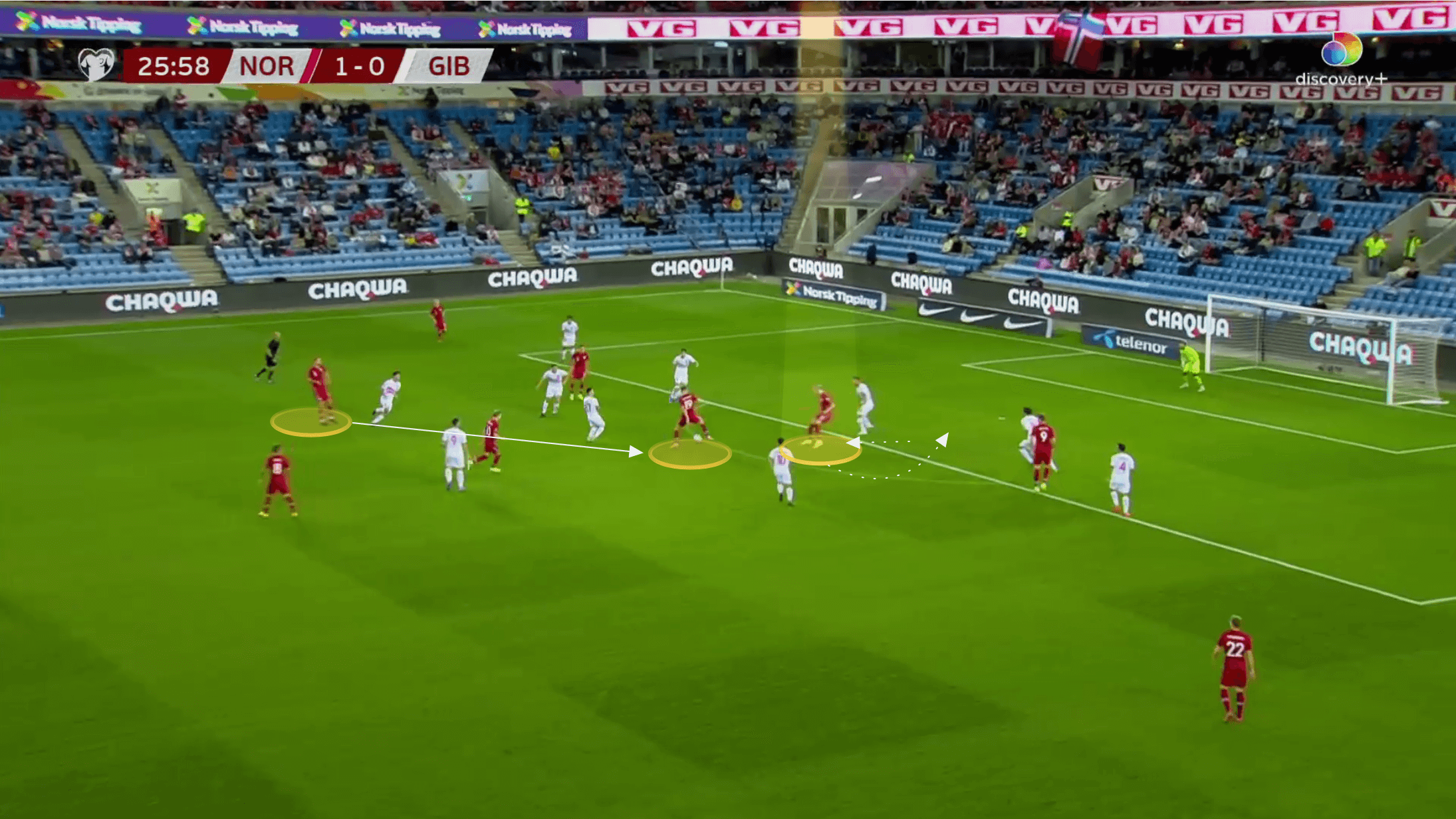
A quick spin-off, opening his body up, and Haaland was able to receive a short through-pass into the space behind.
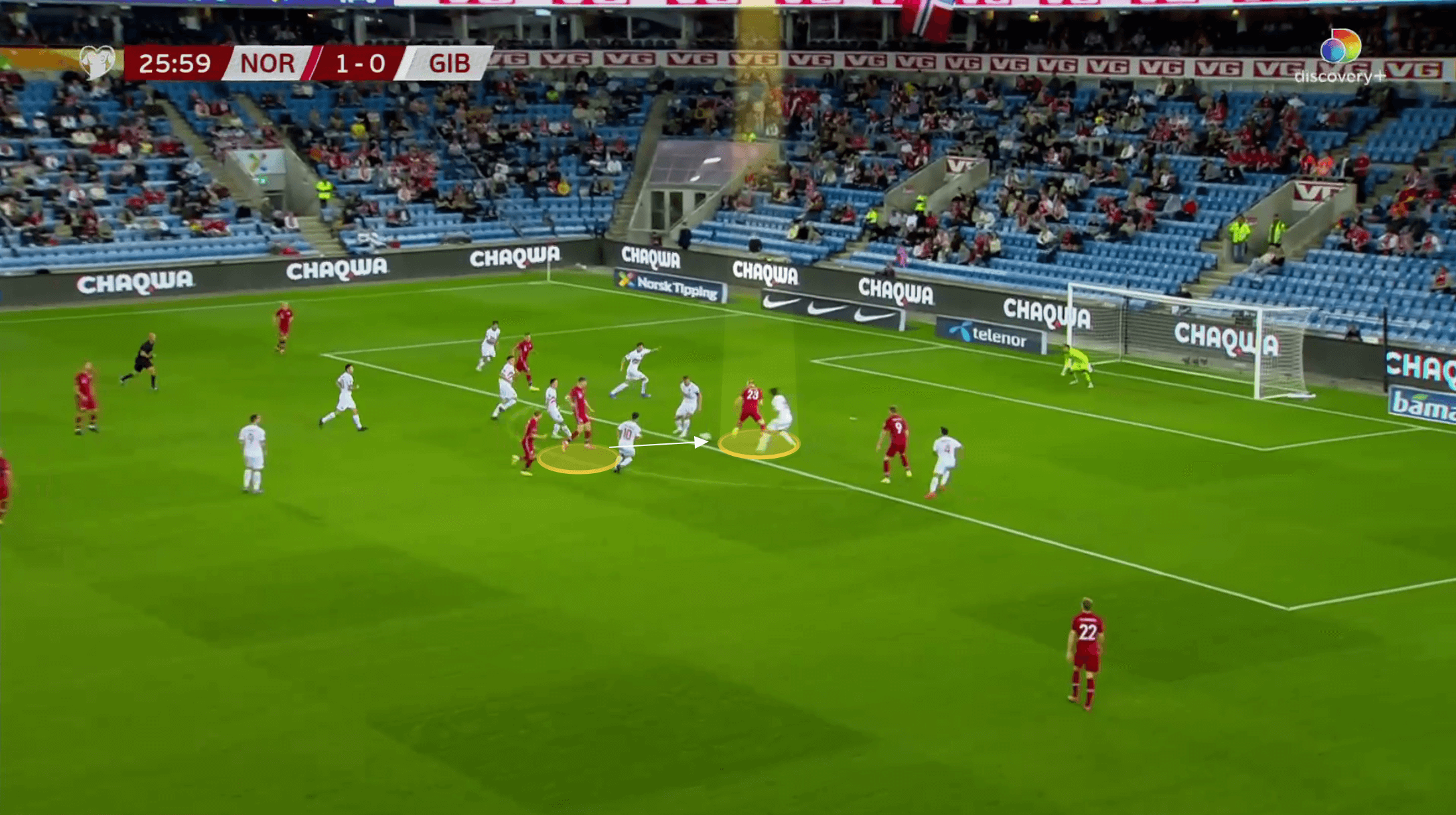
But generally, he will use this double movement in the way shown over the next group of examples.
Haaland’s pace means defenders have to react quickly to any change of direction from the forward, and the Norwegian knows this.
A dart towards the front post, like the one shown in the next image, and Haaland can force the defender to commit to covering him in this direction.
Once he has that reaction he can change direction, shifting his momentum towards the back post.
In doing so, Haaland can often receive the ball a short distance from goal, and unmarked.
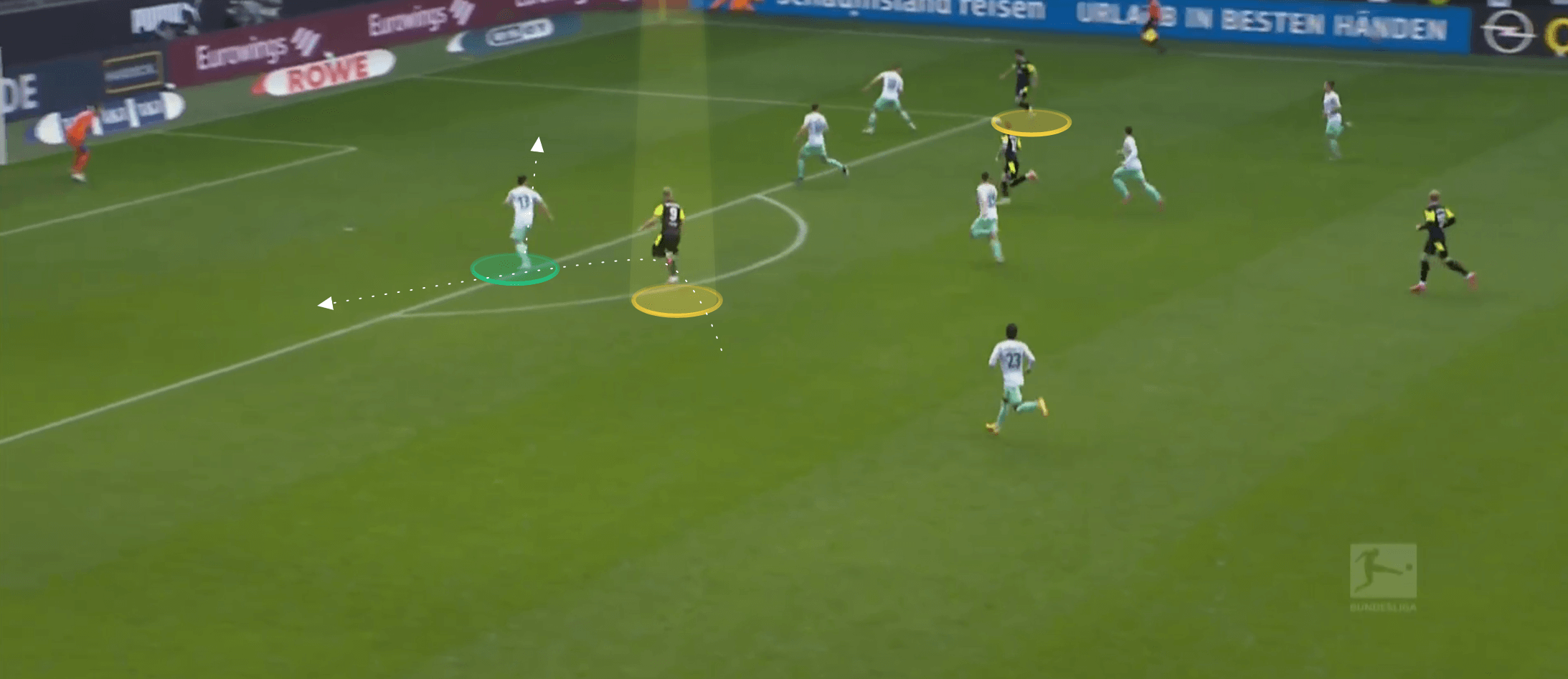
Again we can see the same principle in place in the next example, albeit this time Haaland commits to arriving at the back post.
Note how both Sevilla defenders are watching the ball in this instance, as well as running directly towards their own goal.
Again, as Haaland recognises the opportunity to do so, he halts his momentum, pulling himself towards the front post.
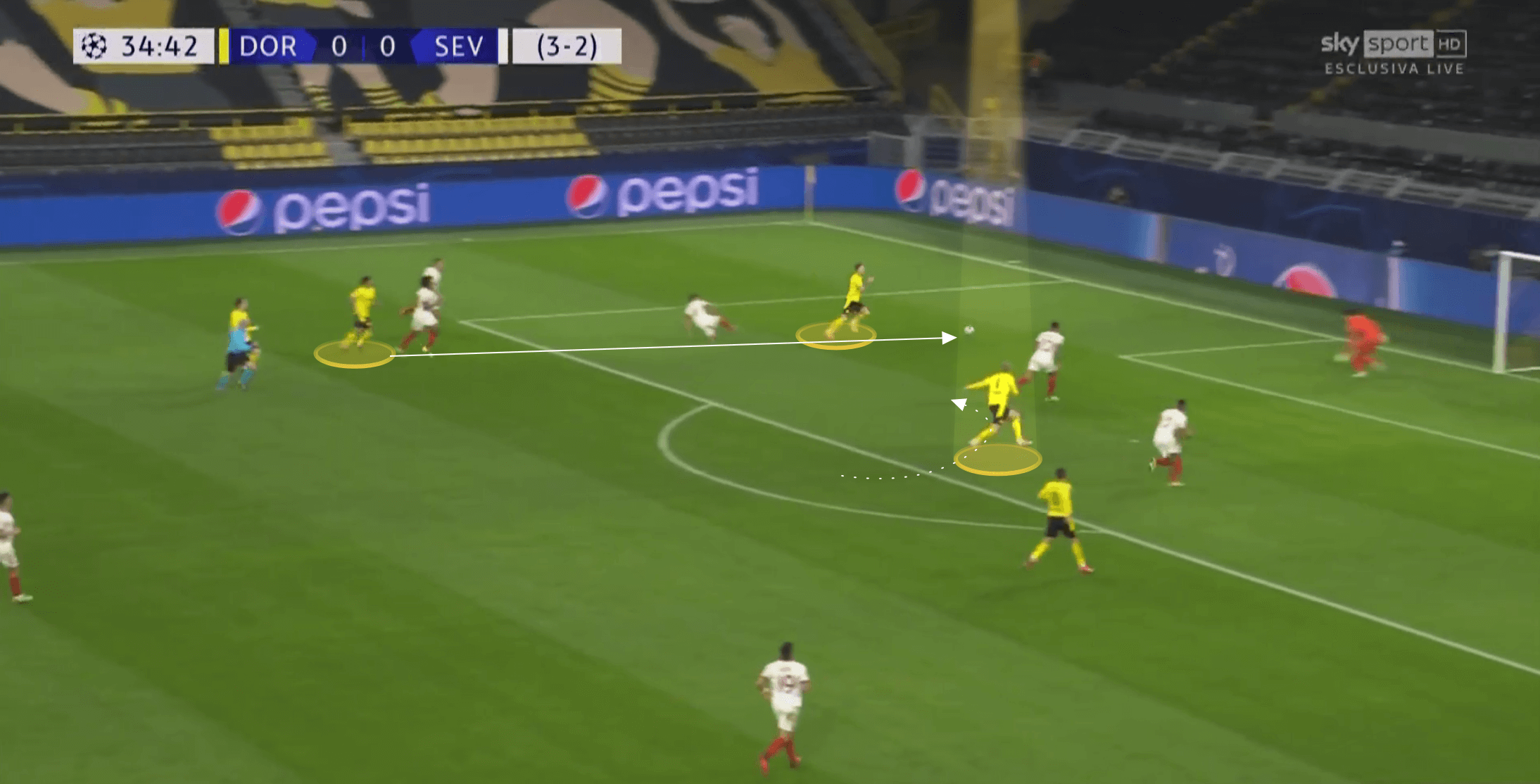
In the next image, we can see the ease of chance he creates for himself with this double movement, again finishing in space with 10 yards of goal.
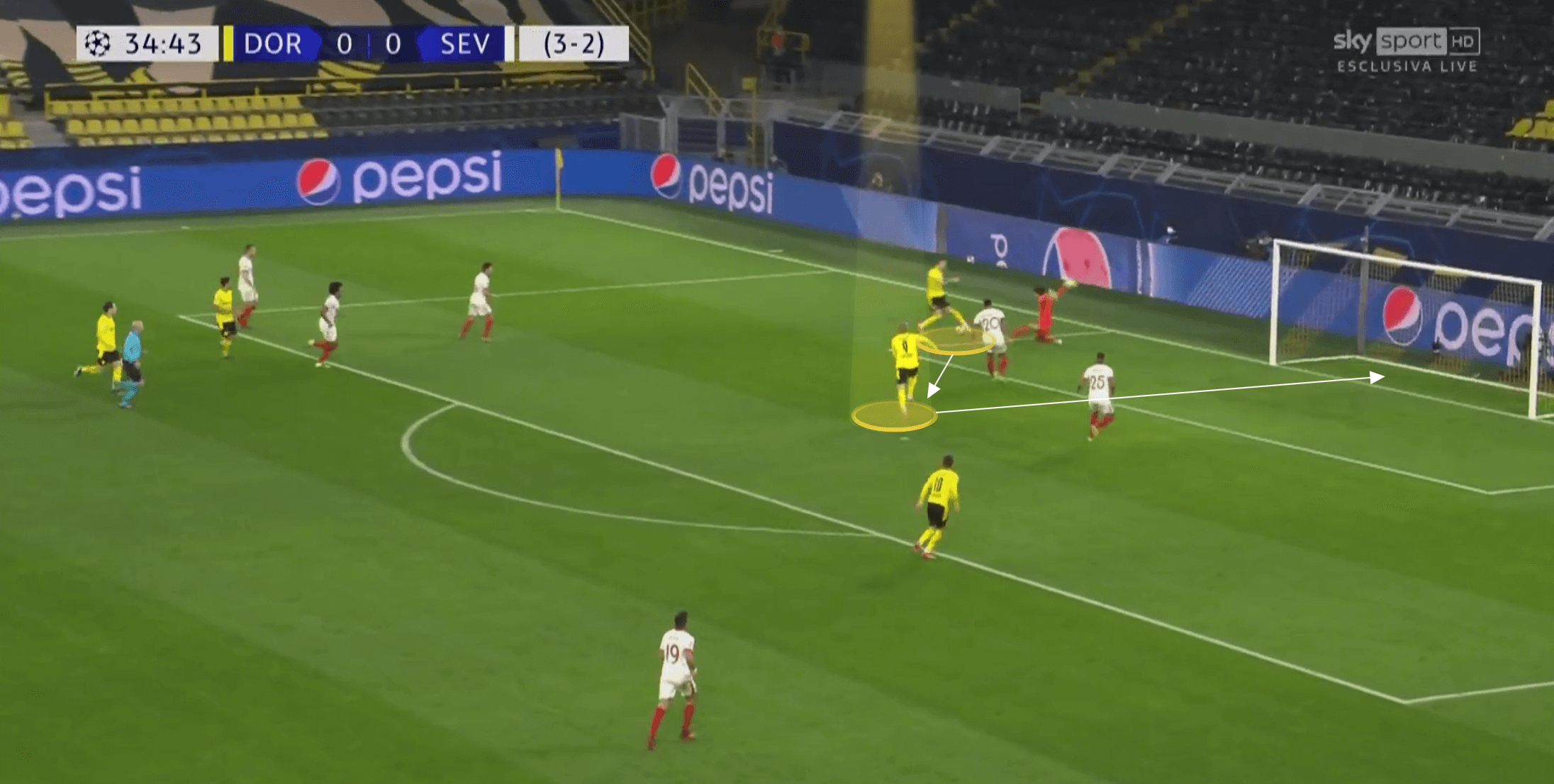
Peeling off of the last man
When Haaland first arrived in Germany he gained a huge amount of success playing against teams who perhaps underestimated his pace and timing when making runs.
As a result, he scored several goals against very high lines, simply receiving a through pass or long ball over the top.
If caught in a foot race with an opponent over a distance longer than 10-15 yards, Haaland will nearly always break away easily, and so playing a high line against him certainly isn’t the best option.
Nevertheless, there are still occasions where it happens, and both Haaland and his Dortmund teammates know how to make the most of these opportunities.
Given the space behind defences in moments of transition, Haaland can be an immediate option for the ball in behind on a counter-attack.
Against Eintracht Frankfurt, we can see Haaland operating as the furthest forward attacker, looping his run to stay onside before looking to receive in behind.
Even if Haaland initially moves early, his ability to curve his run whilst still facing forward, not halting his momentum, is exceptional.
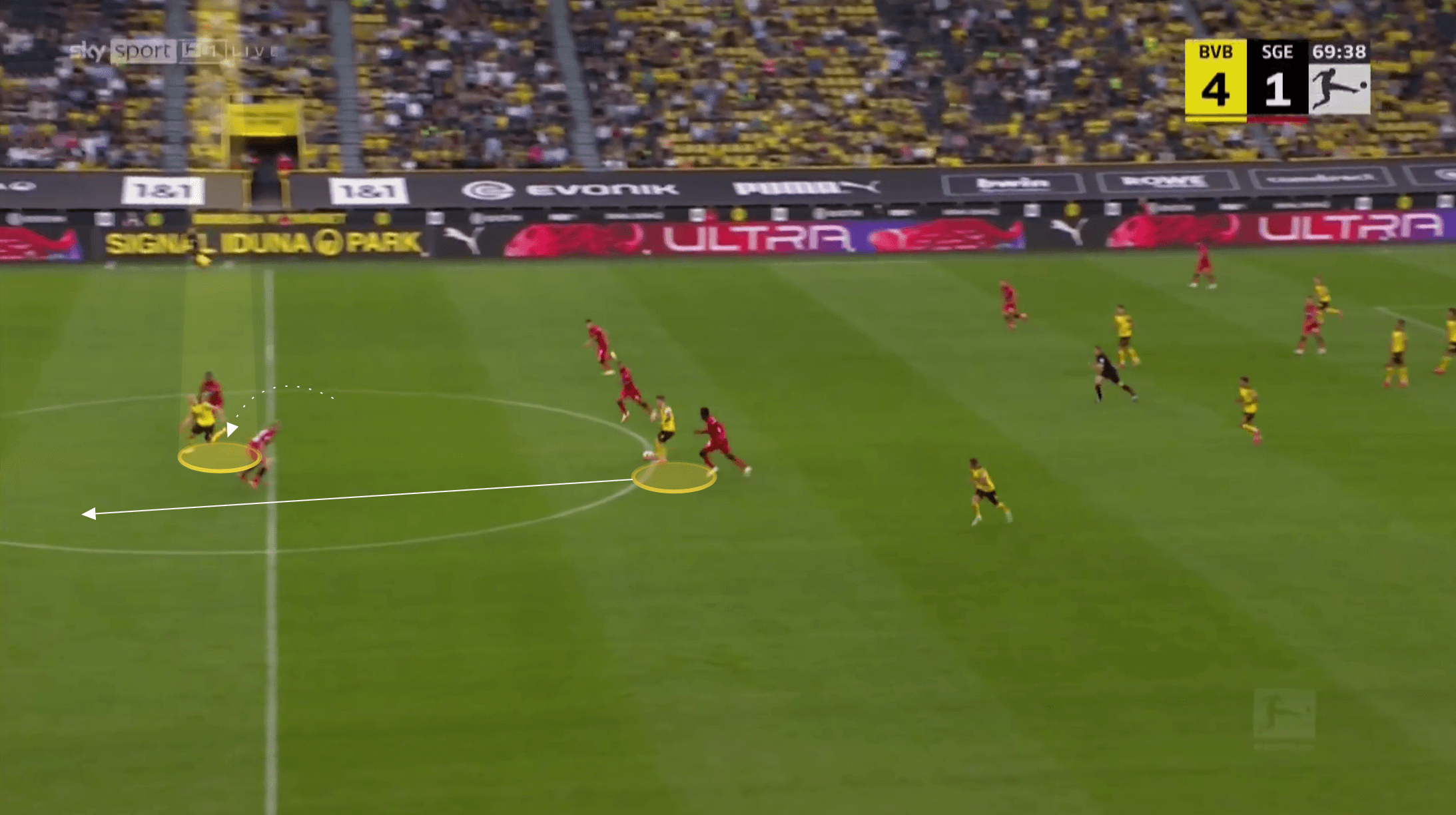
As the ball is played in behind, we can see the type of gaps that Haaland can create for himself against the opposition backline when looking to latch onto such a through pass.
He has the acceleration to initially create the space as well as speed over longer distances.
Even on the ball, Haaland can drive forward with big, aggressive touches, that still often allow him to out-pace recovering defenders.
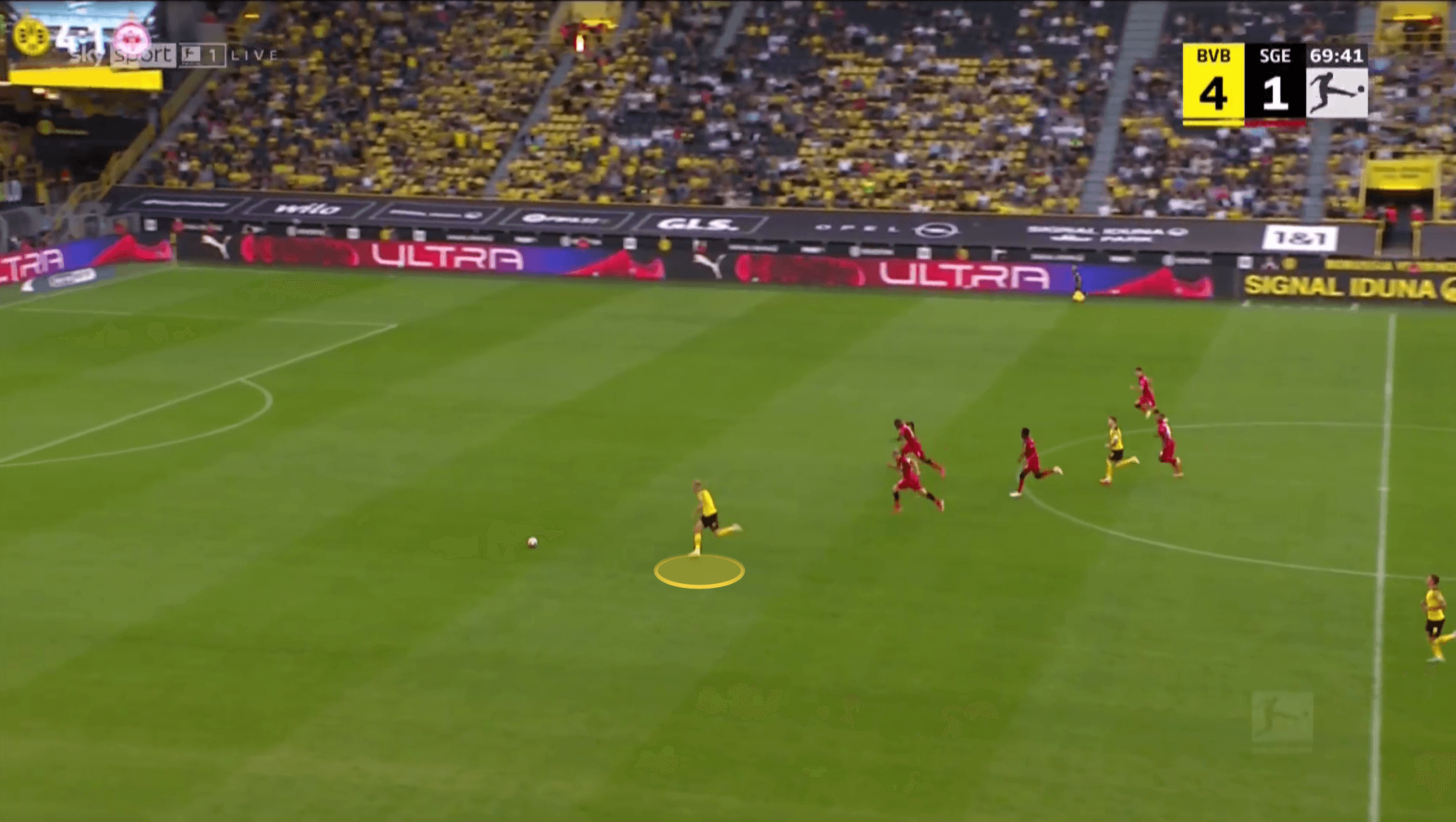
Even against defensive lines that aren’t as high but still leave some space behind, Haaland can time his runs well to access these areas.
He may initially face the ball with his back to the goal, giving the appearance he wants to receive the ball in this position or combine with the ball carrier with some link-up play, but Haaland is quick to turn, loop his run (as we see in the following image), and receive in behind.
He does a good job in this example of pairing himself up against a sole defender, where along with the ball carrier he can isolate them in a 2v1, waiting for them to have to commit even slightly to pressuring the ball carrier before sprinting in behind himself.
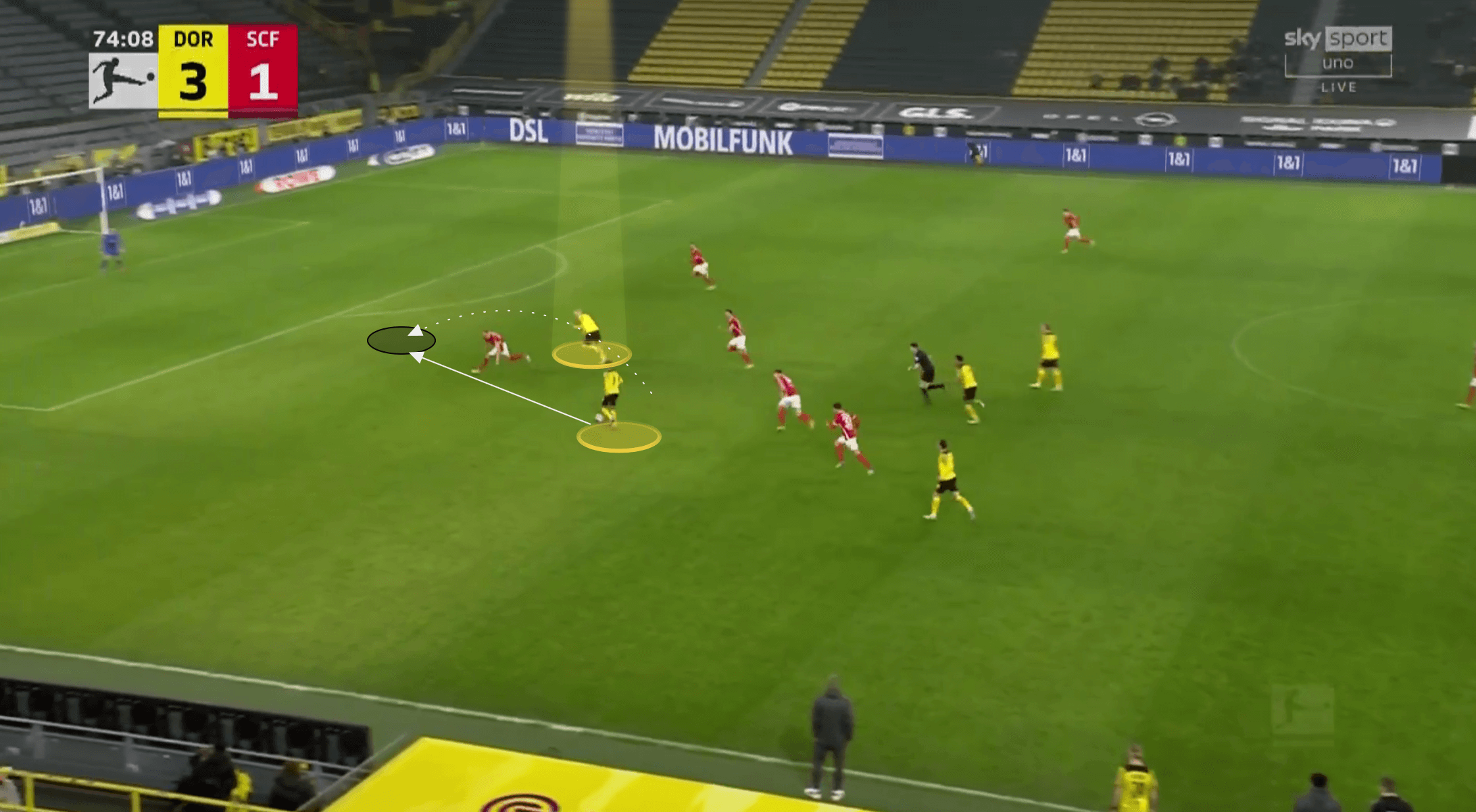
He scored a goal against Wolfsburg as well showing this run timing but also just his anticipation of an opportunity to gain possession in an attacking position, for the through pass came from an opposition player.
With the Wolfsburg left-back under pressure, Haaland began to move forward, anticipating either a pass back to the adjacent centre-back or a misplaced pass.
The result was the latter, and Haaland was already on the move as the pass was played, with Wolfsburg’s defence having little to no chance to recover in this instance.
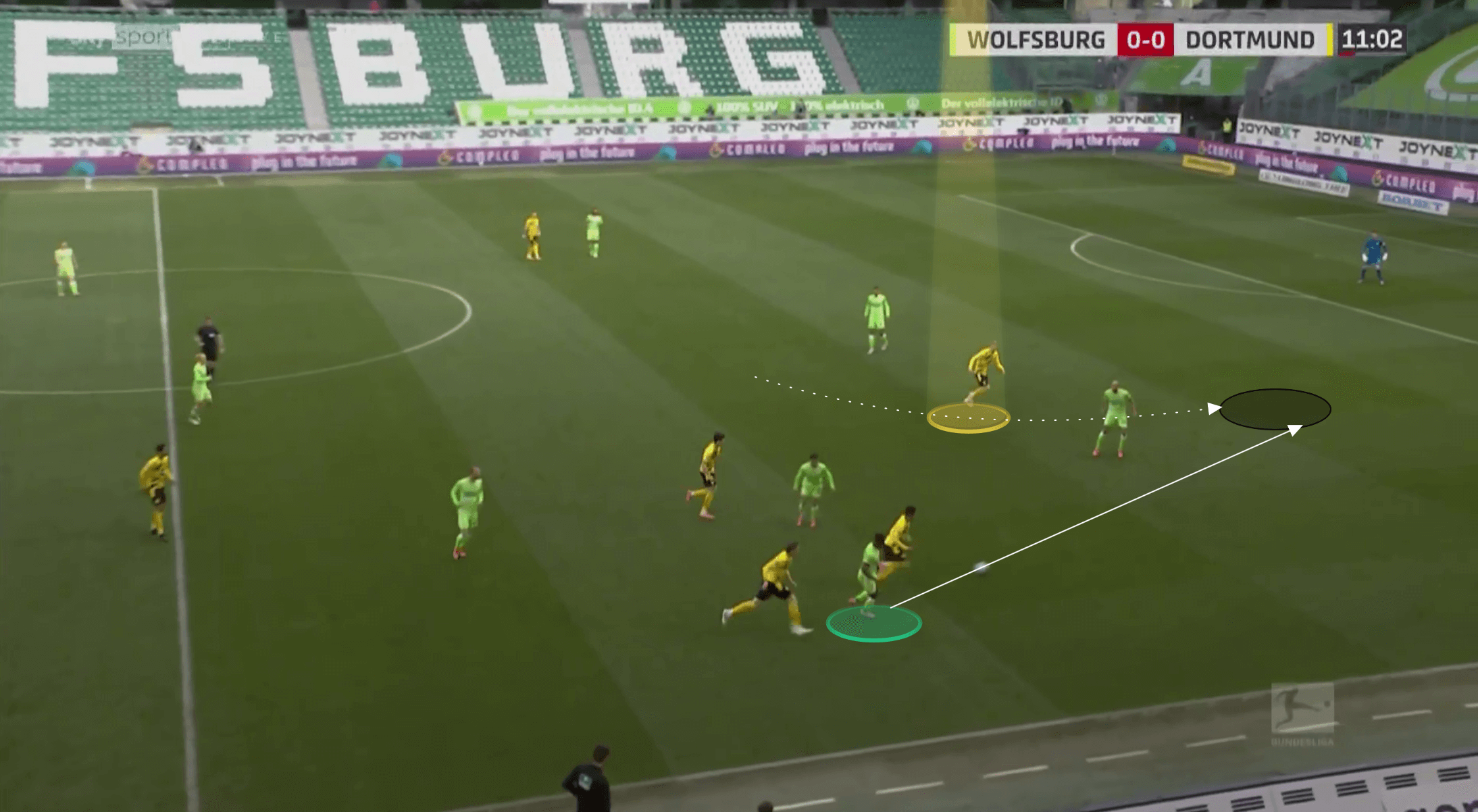
Conclusion
It is these sequences of movement that contribute along with his other assets, such as his size, athleticism, and finishing ability, to make Haaland such a unique centre-forward.
From watching his game, as a coach, it feels apparent that when working with forwards we still put an emphasis on finishing, yet the majority of Haaland’s goals come from open spaces within 12 yards of goal.
This is a result of his movement, and this analysis highlights these coachable movements that the 21-year-old executes with such impressive timing and conviction already.
It’s a cliché but scarily it is true, Haaland will only get better.
He will only add more to his game from this point in his career, but such impressive movement at such a young age is rare.
His movement benefits from his change of pace and agility but, realistically, it is perhaps his timing of these runs that is so difficult for defenders to deal with.
Haaland style of play preys on defenders, catching them in situations where they can’t look at the forward and the ball at the same time, as he lingers off of their shoulders.
Even as Haaland ages, well into his career and in his 30s he may lose that pace somewhat, so he might be less of a threat when there is space in behind.
However, his ability to create space in tight areas isn’t going to go away, and as a result, he could well be an elite forward late into the latter stages of his career, as Bayern Munich’s Robert Lewandowski appears to be, or the infallible Cristiano Ronaldo of Manchester United.





Comments